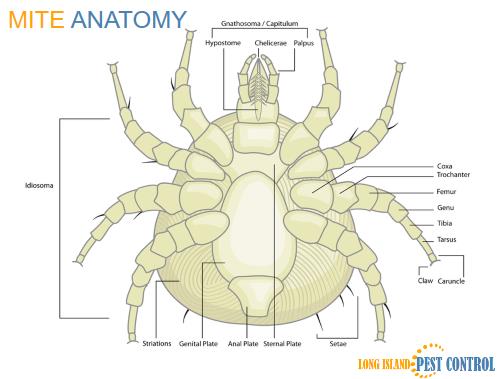
Mite is a term often used to allude to a group of arachnids, some of which bite or cause irritation to human beings. While several mites parasitize mammals, including man, others are scavengers, some feed on plants, and a large number prey on insects and other arthropods. Mites are not insects, and most are visible to the unaided eye, usually measuring 1/8 inch or less in length. In fact, there are almost as many different types of mites as there are insects. Most mites never come in contact with people, but the ones that do can impact the health of humans. In many instances, no causative organism is present where mites or other invisible arthropods are thought to be biting or attacking people. The irritation could be real or imagined: real, caused by mechanical, chemical, or other lifeless irritants, or imagined resulting from a psychological disorder. While mites seldom transmit disease to people in the United States, they unquestionably impact health. Mites occasionally enter Long Island homes and prey upon people in the absence of their usual hosts; birds, rodents, or insects. Mites may merely be a nuisance when they enter a Long island home in large numbers, or they may be associated with allergies causing a severe skin irritation that can result in intense itching.



Mites are not segmented, and their bodies aren't divided by constrictions like ants and spiders.

Mites are invertebrates that possess four pairs of legs.

Mites' mouths consist of a couple of chelicerae that are highly modified in parasitic mites as long and slender structures used to pierce a host's skin to feed on their blood. The two short palps function as sensory organs.

Mites have a gnathosoma, also known as the capitulum, which is essentially their head located on the anterior segment of their body.

Mites' bodies are called idiosomas which bear their legs, genital and anal openings, and various tactile and sensory structures.

The life cycle of a mite is typically composed of four stages: egg, larva, nymph, and adult. The life cycle normally requires one to four weeks and may result in vast populations of mites when favorable conditions exist. The eggs are laid by an adult female mite and will hatch into larvae having six legs. After several molts, the mite larvae become nymphs with eight legs, and after a few more molts, they become adults. Life expectancy varies between mite species, but the lifespan is short compared to many other arachnids.



Scabies Mites - Sarcoptes scabiei are mites found worldwide that infest mammals, including humans. Sarcoptes scabiei causes sarcoptic mange in wildlife and is the most common type of mange found in wild animals. These mites can cause scabies in human beings, and most human infestations result from person-to-person contact. However, the scabies mite can transfer from animals to humans and vice versa. Unlike other mites, scabies mites burrow and produce tunnels one centimeter or more in length just below the skin's surface, in which they lay eggs. Symptoms of scabies include a skin rash and intense itching that worsens during the evening.




Clover Mites - Bryobia praetiosa mites are widely dispersed throughout North and South America, Europe, Asia, Africa, and Australia. Clover mites occasionally enter Long Island homes, causing panic. They are one of the largest plant-feeding mites, and although they don't bite or cause health-related issues, clover mites can be a nuisance.



Bird Mites - The most frequently encountered bird bites are the northern fowl mites (Ornithonyssus sylviarum), chicken mites (Dermanyssus gallinae), and American bird mites (Dermanyssus americanus). Bird mites live on birds and in bird nests and are found throughout the United States. Starlings, pigeons, and sparrows are the birds usually associated with bird mite infestations in Long Island residences and buildings. When baby birds leave their nests in late spring, the bird mites will search for new hosts. Bird mites can cause intense itching when they crawl onto and bite people and pets.



Rodent Mites - Can be found in temperate and tropical regions throughout the world and includes three types of mites: the tropical rat mite (Ornithonyssus bacoti), spiny rat mite (Laelaps echidnina), and house mouse mite (Liponyssoides sanguineus), which opportunistically feed on humans. Rodent mites can survive for long periods without feeding and travel long distances when searching for hosts. Rodent mite bites result in dermatitis in human beings. The tropical rat mite is a vector for the transmission of hantavirus infections between rats and humans, and the house mouse mite is the vector for the transmission of rickettsialpox. The spiny rat mite feeds on rats at night and hides in cracks and crevices around rat nests during the day.
Scabicides are used to treat scabies in humans and mange in animals and are available only with a prescription from a physician or veterinarian. The pest control professionals at Long Island Pest Control can eliminate an infestation of clover mites, bird mites, or rodent mites. Controlling mites is a multistep process. Getting rid of a mite infestation at a Long Island home or business can be a complex procedure. In the absence of the proper training, equipment, and restricted use pesticides, the eradication of an infestation of mites from your Long Island home or place of business is a venture that will prove to fail. Therefore, you should contact the Long Island mite control professionals at Long Island Pest Control. Our Long Island mite exterminators have a vast knowledge of mite control techniques and many years of experience combating mite infestations.